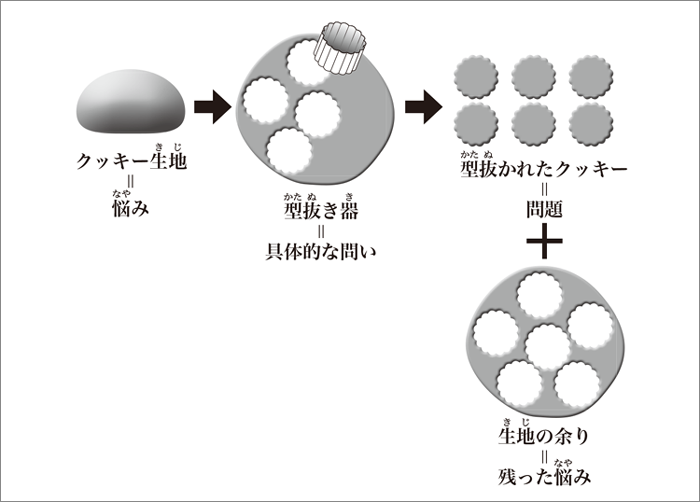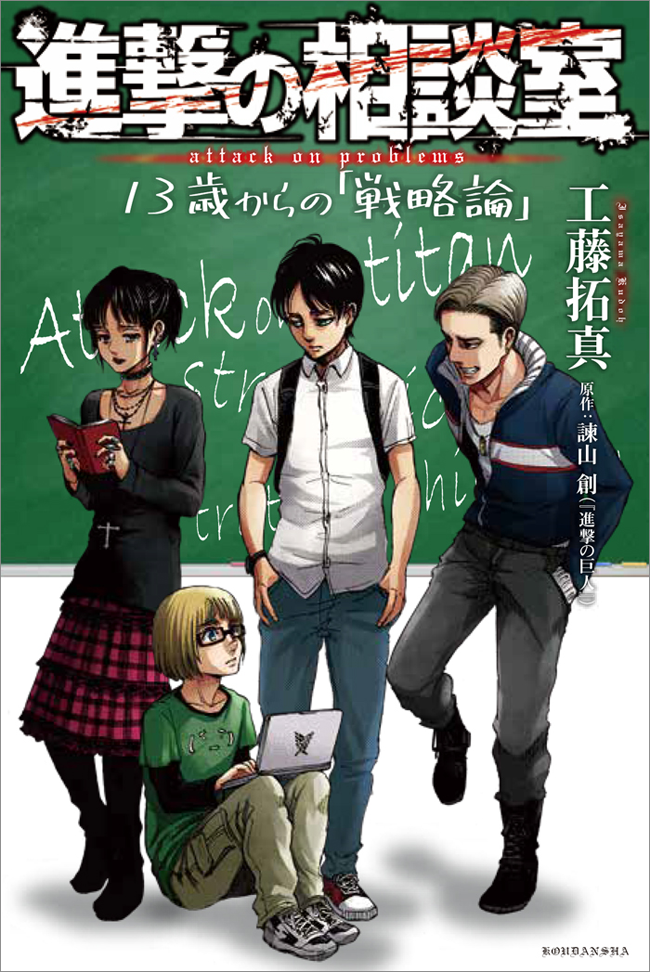The Most Terrifying Strategy Book is Born
"How can we revive the brand that has supported our company for 20 years, adapting it to the demographic shift of a declining birthrate and aging population?"
"We want to make the next three years our IPO push. Within that, we want to launch a second business from scratch, distinct from our founding venture. Where should we start?"
"We're rebuilding the station building. We want it to be a space that inspires not just townspeople, but also the people who work there!"
...etc.
Using strategy as a weapon, we confront the challenges faced by diverse companies and organizations across industries and genres, crafting solutions and creative ideas. That is the work of a Creative Strategist.
Alongside this work, a certain encounter led to an opportunity to create a book. Its name: 'Attack on Consultation Room' (Publisher: Kodansha).
The title makes it clear this work is based on the acclaimed manga 'Attack on Titan'. However, looking at the subtitle reveals this is far from just a fanbook. It bears the words 'Strategy Theory for Ages 13 and Up'.
Indeed, this book uses episodes from 'Attack on Titan,' featuring the exploits of characters like Eren and Mikasa, as material to master the fundamentals of strategic thinking—as "concrete strategies for thinking things through for yourself."
Working across industries with people of diverse ages and backgrounds, I've noticed something: mastering strategic thinking has nothing to do with age.
Strategy is a weapon that's never a liability to possess, starting from the moment people begin to be attacked by the monster called worry. Unfortunately, however, most strategic theories are confined to the history of warfare or specialized fields focused on specific businesses. In other words, they are only discussed as narrow strategic theories.
I often thought, even as a teenager with zero interest in business, how great it would be to encounter broad strategic thinking untethered to specific fields. If such a dream could come true, the world ten years from now would surely be more exciting. Combining the flexible ideas of youth with strategic thinking would undoubtedly foster a new generation ready to change the world.
Such a crazy fantasy lingered in the back of my mind.
It was because Kodansha found this dream story intriguing that the book project began.
Moreover, I've always held a special place in my heart for the work Attack on Titan. Needless to say, I thoroughly enjoyed it as the ultimate, terrifying entertainment. Beyond that, this story is a "textbook of strategic thinking," brimming with practical problem-solving ideas that rival even the thickest specialized strategy manuals.
Not only the iconic scenes familiar to fans, but even the seemingly casual dialogue is packed with strategies that make experts shudder. Yes, those moments where fans exclaim, "Wow... that's Armin the strategist for you!" hide brilliant tactics.
While this book is primarily crafted for Attack on Titan fans and middle/high school students, its core content is useful for eliminating the "worries" lurking in the lives of all business professionals, regardless of age or whether in public or private life. Therefore, this series will focus on key points useful for all business professionals, regardless of job type, conveying the essence of 'Attack on Titan Consultation Room' from a strategic creative perspective.
Spend your time training to defeat problems, not searching for answers
Living in this cruel world unarmed is not courage.
It is mere recklessness.
First, we must possess the "weapons" to survive.
This book begins with such words.
Of course, the real world we live in isn't like the one Eren and Levi inhabit. We don't suddenly get eaten by giants. We aren't trapped behind towering walls.
Yet this reality can be just as cruel as fiction—perhaps even more so. "Giants called friends or colleagues" who hurt people without a second thought run rampant, while suffocating "walls called classrooms or workplaces" block our path. In other words, we are constantly surrounded by various troubles and have no choice but to live with them.
Precisely because this world is so cruel, just as Eren carries weapons to fight the Titans, we must not confront our troubles unarmed. We must carry weapons to defeat these formidable foes. That is precisely what "strategic thinking" is as a problem-solving tool.

However, the "weapons" referred to here are not the answers themselves.
We live in an incredibly convenient era. Browse business books or search web news on your smartphone, and you'll instantly find appealing "answers" like "Understand ●●● in 5 Minutes" or "The Only Way to Solve ●●●."
But it's highly unlikely that these "answers" will perfectly fit your specific problem. And that's understandable. After all, each of us is different. Problems come in countless shapes and forms. What's more, since problems are invisible, it's hard for others to see what exactly someone is struggling with. In fact, even the person themselves often doesn't know the true nature of their problem.
Given this situation, a one-size-fits-all answer isn't guaranteed to be the perfect fit for you. And even if such an answer existed, there's absolutely no guarantee you'd find it easily in business books or web news articles.
So who provides the solution to "my unique problem"? Obviously, the ultimate anchor is yourself. And only yourself.
Thinking about it this way, you realize that every time you hit a wall, spending time searching for a "perfect fit" solution for your immediate problem is actually poor value for time. Even if a quick fix works, in this world, a different problem will pop up again in a few days.
Therefore, if you're going to spend the same amount of time, it's better to invest it in "training to overcome problems" rather than "searching for answers to problems." This will strengthen your work sustainably. Once you've built up that strength, you can apply it to other problems.
For example, compare someone who got into university by following someone else's methodology with someone who devised their own creative study method and succeeded. Even though both are university students, their problem-solving abilities are clearly very different. In today's society where rules change constantly, it goes without saying that people with the latter kind of ability have a broader stage for success.
This book addresses precisely that: strategic thinking as a weapon to fight such struggles.
From "Worrying" to "Thinking"
As the first step to banish worry, this book teaches:
"Use 'worry' and 'think' appropriately!"
When faced with a dilemma in business or daily life, two reaction patterns emerge: "wor
In both business and daily life, when faced with a problem, there are two reaction patterns: "worrying" and "thinking." At first glance, the difference may seem subtle. But if you look inside your mind, they are vastly different.
A "worrier" is lost in a fog. They stand frozen, unable to grasp any clue about how to defeat the monster of worry. On the other hand, a "thinker" sets specific questions and clears away worries one by one. In other words, a "thinker" can give shape to an elusive worry through concrete questions.
This book explains this concept using the analogy of "cookie making."
If we liken the cookie dough to "worry" and the cookie cutter to "(the specific question set by the thinking person)," it looks like the diagram below.

By preparing a specific question, the vague "worry" transforms into a clear "thought = problem."
Of course, just as some scraps remain no matter how skillfully you use the cookie cutter on the dough, worries never disappear 100%. Still, the significance of using specific questions to switch most worries into solvable problems is immense.
This leads to the next critical question: "How do we transform from someone who worries into someone who thinks? What are the concrete steps?" Incidentally, we must insist on the term "concrete steps" here. We must be careful not to settle for mere willpower or vague answers.
This is because the difference between the "worrier" and the "thinker" here is often glossed over with simplistic terms like "sense," "talent," "character," or "personality."
Nonsense like "People who tend to worry are just born that way under a certain star, so it can't be helped" is rampant in both educational and business settings.
But that's not actually the case. If you have the switch (converter) to transform "worrying" into "thinking" – in other words, the tools for thinking – then anyone can acquire the "thinking power" needed to face this cruel reality.
This book serves as a training manual for developing broad strategic thinking. It does this by revealing the strategic structure hidden within the story of Attack on Titan, utilizing the weapon of the "Seven Strategic Switches."
(To be continued)





